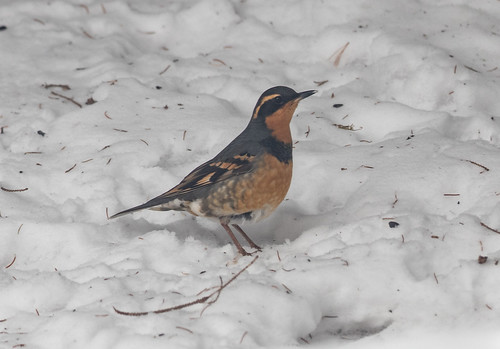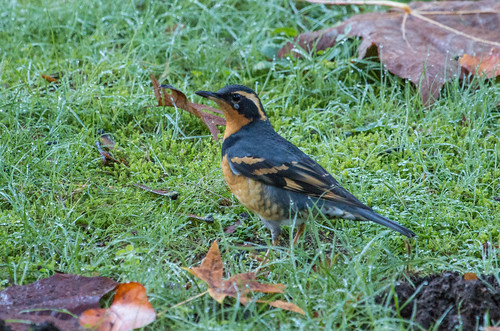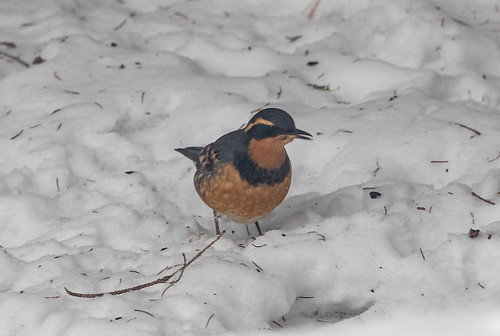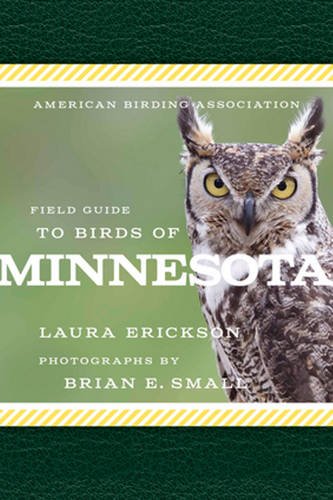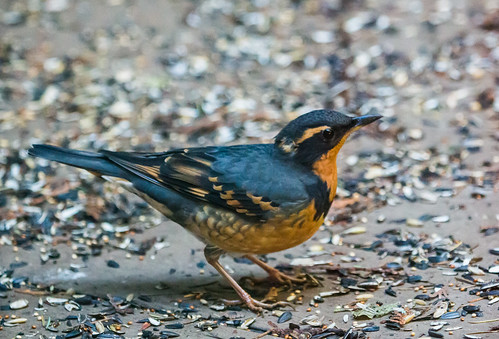Ships are exceptionally costly environmentally, with a huge carbon footprint and toxic emissions into both the air and water from the highly polluting bunker fuel that powers them, to say nothing of how most of them dispose of raw sewage. I did a lot of research to find a small, environmentally responsible company; sadly, it's now out of business. So that remains the only cruise Russ and I have ever taken. And the Varied Thrushes I heard on those wonderful mornings remain the only ones I've ever heard.
I've been to other locations in the Pacific Northwest where Varied Thrushes breed, but never during their breeding season, so they were very quiet. And most of the Varied Thrushes I've seen since my lifer in 1981 have been far, far from where this species sings and ostensibly belongs—my lifer was in Adams County, Wisconsin, and I've seen them a few other times in Wisconsin and several times in Minnesota, including, once, in my own backyard. And last weekend I saw one just five or six miles north of my house, when I was invited by Jean Runquist to see one visiting her yard.
This "fancy robin" breeds through most of Alaska, Yukon, and the Northwest Territories through British Columbia and parts of Washington, Oregon, and even Idaho and northwestern Montana. Most of them winter along the Pacific Coast from Alaska to southern California. But for some reason, some individual Varied Thrushes travel to the beat of a different drum, wandering further east than the vast majority. Most of these outliers remain in the western United States, but a handful of them wander even further off the beaten path. During what we call irruption winters, one or even a small group might appear just about anywhere in the United States and Canada. None of these movements is clearly understood, but at least one or two turn up just about every winter in Minnesota and Wisconsin, perhaps most regularly in Duluth.
When I wrote the American Birding Association Field Guide to Birds of Minnesota, I was limited to covering 300 species, but rare as it is, I couldn’t imagine leaving out the Varied Thrush. When one does show up, it usually appears in someone’s backyard, and is conspicuous enough that people notice and want to know what it is.
The only Varied Thrush I've ever seen in my own backyard in all the years I’ve lived here was chased off by a shrike less than an hour after I discovered it. At the time, my yard had only a few big spruces and no pines—now it has even fewer, so I’m not holding my breath waiting to see another here.
I have seen many Varied Thrushes within a couple of miles of my place over the years, most in yards with feeders, near big stands of conifers. Varied Thrushes seldom actually visit those feeders—the one I saw this weekend was eating corn, sunflower seeds, and pine seeds on the ground. I suspect the other birds visiting the feeders attract the attention of the out-of-place wanderer, and conifers and spilled seed hold their interest. I've only rarely seen them in fruit trees.
As much as Varied Thrushes look like robins, they’re classified in their very own genus, Ixoreus, which comes from the Ancient Greek ixos, for "mistletoe." Varied Thrushes aren’t particularly known to eat mistletoe, but the plant is characteristic of the deep, moist forests where they breed, so they may use it as people do, not as food but as a prompt for romance.
